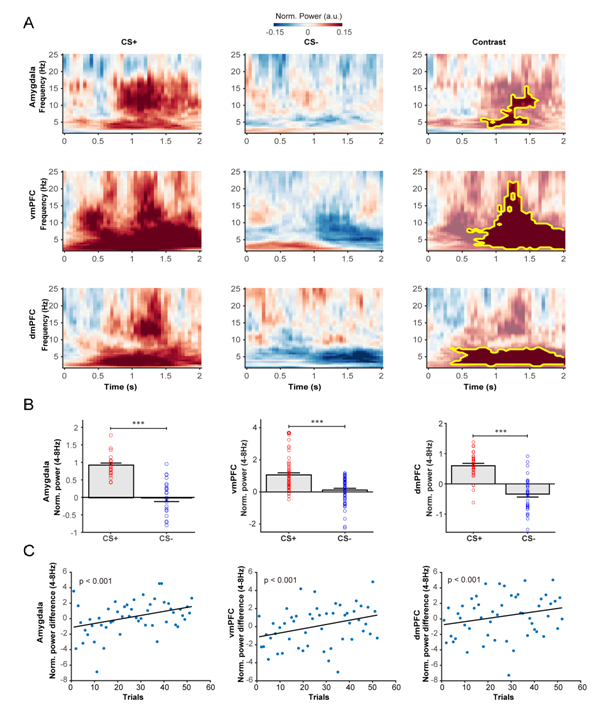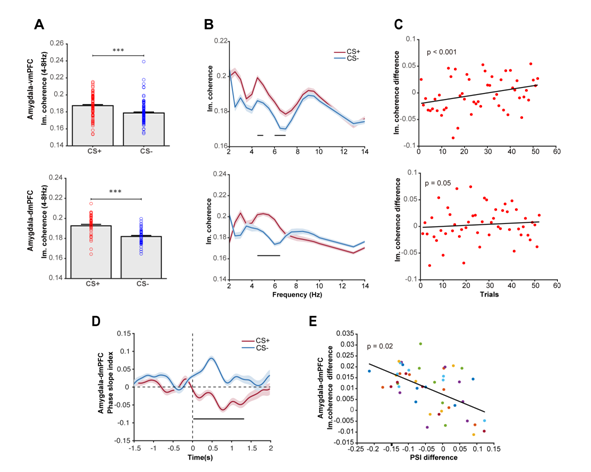Knowing which stimuli in the environment pose a threat to oneself is essential for biological adaptability. When the organism perceives potential threat, it will feel fear and then adopt a series of defensive reactions. However, abnormally excessive fear may affect our health and lead to a number of mental disorders, such as anxiety disorder and post-traumatic stress disorder. For now, it is urgent to find a solution to effectively intervene fear-related diseases. Exploring neural mechanisms of human fear behaviors can help us to deeply understand the pathogenesis of fear-related diseases.
Numerous animal studies have demonstrated that fear acquisition and expression rely on the coordinated activity of medial prefrontal cortex (mPFC) and amygdala, and that theta oscillations support interregional communication within the fear network. However, it remains unclear whether these results can be generalized to fear learning in humans. Moreover, previous studies have mostly focused on the expression and extinction of fear, and there has been little exploration of the process of fear learning. To addressed this question, the research group led by Prof. WANG Liang from the Key Laboratory of Mental Health of the Chinese Academy of Sciences (CAS) and collaborators conducted a study using intracranial electroencephalography (iEEG) technique in 13 drug-resistant epilepsy patients who performed a fear conditioning task.
The study found increases of theta (4-8Hz) power in amygdala and mPFC and of theta synchronization between these two regions for conditioned stimulus (CS)+ vs. CS- stimuli (Fig.1). Analysis of information flow revealed that the dorsal mPFC (dmPFC) significantly led amygdala activity in theta oscillations (Fig.2). Finally, a computational model of associability (fit by SCR data) showed that trial-by-trial changes in amygdala theta oscillations predicted the model-based associability. This study provides direct evidence for the role of the amygdala in fear learning.

Figure 1. Theta power in amygdala, dmPFC and vmPFC during fear learning. Image by WANG Liang.

Figure 2. Theta coherence between amygdala and mPFC during fear learning. Image by WANG Liang.
In summary, this study demonstrated that theta oscillations built up long-range communication and directional information transfer within amygdala-mPFC circuits during fear learning, which provides important evidence for neural mechanisms of fear acquisition. It will help us to understand the formation process of fear-related diseases and provide an important reference for the early clinical treatment.
This study was supported by the Strategic Priority Research Program of Chinese Academy of Science, the National Key Research and Development Program of China, the Beijing Municipal Science and Technology Commission, the National Natural Science Foundation of China and CAS Interdisciplinary Innovation Team. The study entitled “Theta oscillations synchronize human medial prefrontal cortex and amygdala during fear” has been published on August 18, 2021 in Science Advances.
Chen, S., Tan, Z., Xia, W., Gomes, C. A., Zhang, X., Zhou, W., … Wang, L*. (2021). Theta oscillations synchronize human medial prefrontal cortex and amygdala during fear learning. Science Advances, 7(34), 1–14.
LIU Chen
Institute of Psychology
Chinese Academy of Sciences
Beijing 100101, China.
E-mail: liuc@psych.ac.cn
